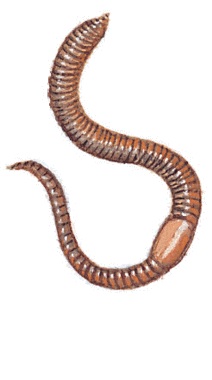 Understanding Earthworms - December 7, 2016 Jeff Schalau, Agent, Agriculture & Natural Resources University of Arizona Cooperative Extension, Yavapai County Earthworms are usually considered valuable to gardeners because they consume and process organic matter converting it into plant-available nutrients. Worm burrows provide easy channels for root growth that are lined with readily available plant nutrients and provide air spaces where oxygen is available for plant roots. In addition, earthworms improve soil structure by mixing organic matter with deeper soil layers and excreting compounds that bind soil particles together. This activity increases the ability of soil to accept water and allows it to penetrate more deeply into the soil profile. Prior to European settlement, North America had few species of earthworms and northern forests had no native earthworms. When the glacial ice retreated about 10,000 years ago, there were no worms present in these soils. Once European settlers began colonizing North America, they brought ships. These ships needed ballast to keep them properly afloat. Soil was commonly used as ballast and earthworms and invasive weeds were inadvertently transported to the New World. The non-native worms flourished as they had no natural predators and were more aggressive than native species living in more temperate latitudes. This has resulted in accelerated nutrient cycling in northern forests. Many scientists think the introduction of earthworms has had a negative effect on these ecosystems. There are over 1,800 species of earthworms worldwide which range in size from a few millimeters to a meter in length. The most common worms in North America, Europe, and Western Asia belong to the family Lumbricidae, which has about 220 species. Nightcrawlers live in soil and are collected from fields and lawns at night. They are not often “farmed” commercially due to their slow reproductive cycle. Field worms also live in soil, are smaller, and also breed slowly. Manure worms (also called brandlings, red wigglers, or angleworms) and red worms live in organic debris and are the preferred types for commercial bait production and composting. While considered primitive, the earthworm has well-developed nervous, circulatory, digestive, excretory, muscular, and reproductive systems. Earthworms breathe through their skin and must be in an environment that has at least 40 percent moisture (at least as damp as a wrung out sponge). If their skin dries out they cannot breathe and will die. Earthworms prefer a near-neutral soil pH. For these reasons, earthworms in Arizona are most common in riparian ecosystems (areas adjacent to flowing and standing water), regularly cultivated areas, and in or below compost piles. Instead of teeth, earthworms have a gizzard, like a chicken, that grinds the soil and organic matter they consume. Worm excrement is commonly called worm casts or castings. These soil clusters are glued together when excreted by the earthworm and are quite resistant to erosive forces. Castings contain many more microorganisms than food sources because their intestines inoculate the casts with microorganisms. The earthworm's digestive tract is highly adapted to its burrowing and feeding activities. The worm swallows soil (including decomposing organic residues in the soil) or residues and plant litter on the soil surface. Strong muscles mix the swallowed material and pass it through the digestive tract as digestive fluids containing enzymes are secreted and mixed with the materials. The digestive fluids release amino acids, sugars, and other smaller organic molecules from the organic residues. In addition, the castings contain living protozoa, nematodes, bacteria, fungi, and other microorganisms as well as partially decomposed plant and animal materials. Earthworms become sexually mature when the familiar band (the clitellum) appears around their body, closer to their mouth. Each worm with a clitellum is capable of mating with other worms and producing cocoons that contain baby worms. Cocoons are lemon shaped and slightly smaller than a pencil eraser. The eggs hatch after about three weeks, each cocoon producing from two to twenty baby worms (four is the average). Gardeners often see night crawlers and field worms when working garden soil, during irrigation, and in soil around active compost piles. More enthusiastic gardeners use manure worms and/or red worms to make compost. This is called vermiculture or vermicomposting and requires some care to maximize compost production and sustain/increase worm populations. Some home gardeners make vermicompost using plastic bins and feed their worms kitchen scraps. More earthworm and vermicomposting information is included in the online edition (see URL below). Follow the Backyard Gardener on Twitter – use the link on the BYG website. If you have other gardening questions, call the Master Gardener help line in the Camp Verde office at 928-554-8992 or e-mail us at verdevalleymg@gmail.com and be sure to include your name, address and phone number. Find past Backyard Gardener columns or provide feedback at the Backyard Gardener web site: http://cals.arizona.edu/yavapai/anr/hort/byg/. Additional Resources  A mature common earthworm (Lumbricus terrestris) showing the clitellum: the different colored band near the middle of the image (Joseph Berger, Bugwood.org). Earthworms (with photos of worm burrows and reproductive structures) The Ohio State University extension.illinois.edu/soil/SoilBiology/earthworms.htm Worm Composting (for Home Gardeners) Clemson University Extension www.clemson.edu/extension/hgic/plants/other/compost_mulch/hgic1607.html Raising Earthworms Successfully (for Larger Worm Farms) North Carolina Cooperative Extension Service www.bae.ncsu.edu/extension/ext-publications/waste/composting/agw-641_rasing-earthworms.pdf European Earthworms in Minnesota (discusses ecological impacts) University of Minnesota Extension www.extension.umn.edu/garden/insects/find/european-earthworms-in-minnesota/ |